
Ubiquinone (Coenzyme Q) Biosynthesis in Plants: Free that Ring
Soubeyrand et al. use genetic and biochemical evidence to show that Arabidopsis and tomato can derive the ubiquinone precursor 4-hydroxybenzoate from the B-ring of kaempferol. Plant Cell https://doi.org/10.1105/tpc.18.00688.
By Eric Soubeyrand, Timothy S. Johnson, and Scott Latimer, University…

Enzymatic Sweeteners as Tools for Biotech Applications
Louveau et al. investigate plant natural products in the large family of enzymes called arabinosyltransferases https://doi.org/10.1105/tpc.18.00641
Background: Plants produce a diverse array of natural products. These compounds have important ecological functions, providing protection against pests,…
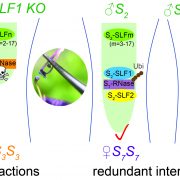
Petunia Battlefield in Style: S-RNases vs. SLF proteins
Sun et al. use CRISPR/Cas9 in Petunia to establish the essential role of SLF proteins in self-compatibility and reveal their complex interactions with S-RNases. Plant Cell https://doi.org/10.1105/tpc.18.00615.
By Linhan Sun and Teh-hui Kao, The Pennsylvania State University
Background: Plant…
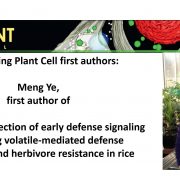
Recognizing Plant Cell first authors: Meng Ye
Meng Ye, first author of Molecular dissection of early defense signaling underlying volatile-mediated defense regulation and herbivore resistance in rice
Current Position: Associate Professor in Tea Research Institute, Chinese Academy of Agricultural Sciences
Education: PhD in Entomology (2016),…

Tomato Hairs and Metabolites - A Dual Narrative
Xu et al. find that the transcription factor SlMYC1 is involved in trichome formation and regulates mono- and sesquiterpene biosynthesis differentially in leaf and stem trichomes in tomato.
By Robert Schuurink, Department of Plant Physiology, University of Amsterdam, NL
Background: Many plants…
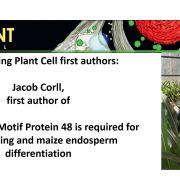
Recognizing Plant Cell first authors: Jacob Corll
Jacob Corll, first author of RNA Binding Motif Protein 48 is required for U12 splicing and maize endosperm differentiation
Current Position: OPS Lab Assistant, Horticultural Sciences, University of Florida, FL
Education: Biology, M.S., Oakland University, Rochester, MI 48309 USA; Biology, B.S., Oakland…
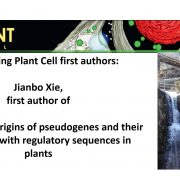
Recognizing Plant Cell first authors: Jianbo Xie
Jianbo Xie, first author of Evolutionary origins of pseudogenes and their association with regulatory sequences in plants
Current Position: Associate professor of College of Biological Sciences and Technology, Beijing Forestry University, Beijing, China
Educations: 2010-2015, Ph. D. College of Biological…
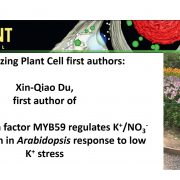
Recognizing Plant Cell first authors: Xin-Qiao Du
Xin-Qiao Du, First author of The Transcription Factor MYB59 Regulates K+/NO3- Translocation in the Arabidopsis Response to Low K+ Stress
Current Position: Ph.D, State Key Laboratory of Plant Physiology and Biochemistry, College of Biological Sciences, China Agricultural University, Beijing, China.
Education:…
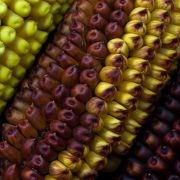
The Identity of an Unstable Pigmenting Factor
Wittmeyer et al. discover a CACTA element that regulates ufo1 epialleles. Plant Cell (2018) https://doi.org/10.1105/tpc.18.00546
By Kameron Wittmeyer and Surinder Chopra
Background: A single gene can produce different outcomes depending on when, where, and at what levels it is turned on. A classical…

